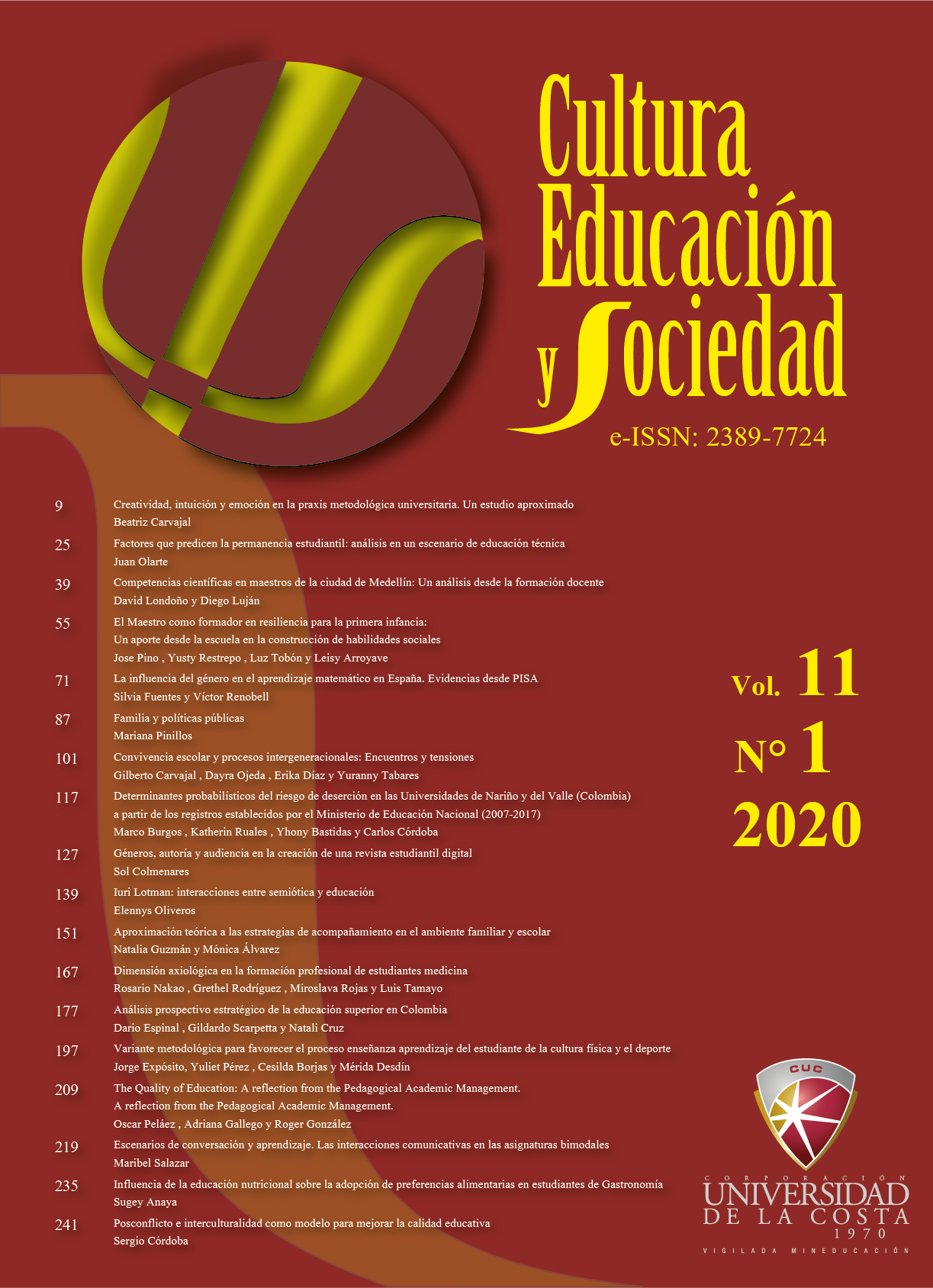Genres, Authorship and Audience in the Process of Creating a Digital Student Magazine
DOI:
https://doi.org/10.17981/cultedusoc.11.1.2020.09Keywords:
Writing, Autor, Audience, Magazine, PedagogyAbstract
The journals created by students are pedagogical projects that offer the opportunity to address the writing of different genres with a specific audience, a fundamental practice for potential authors. This article presents partial results of the research Rites of scientific initiation: the process of creating a digital student magazine, in order to analyze how a group of students of a degree in foreign languages assumes the task of creating content for a jurnal Digital student, In the methodological framework of the systematization of experiences, the corpus composed of texts written by students and the data obtained through surveys, observation sheets and interviews are analyzed to answer the following questions: What discursive genres do students recognize as their own? of a digital magazine aimed at foreign language learners? And what genres do teachers consider should be incorporated into a student digital magazine? The results highlight the trial as the most common genus found in the corpus; also highlight instructive, advice and biographical stories of notorious significance in the experiences identified. It concludes in the importance of the academy for the conformation of personal experiences, autobiographical stories and life stories as legitimate references, not only for the search of writing topics, but also in relation to the effective use of rhetorical strategies and for the construction of authorship.
Downloads
References
Barnechea, M. y Morgan, M. (2010). La sistematización de experiencias: producción de conocimientos desde y para la práctica. Tendencias y Retos, (15), 97–107. Disponible en http://www.ts.ucr.ac.cr/binarios/tendencias/rev-co-tendencias-15-07.pdf
Bazerman, Ch. (2009). Genre and Cognitive Development: Beyond Writing to Learn. Pratiques, (143–144), 127–138. https://doi.org/10.4000/pratiques.1419
Blanco, M. y Mosquera, H. (2019). El lenguaje valorativo en artículos de investigación sobre interculturalidad en la enseñanza de lenguas: Análisis discursivo de las introducciones de artículos publicados en una revista internacional especializada en lenguaje y comunicación intercultural. (Tesis de Maestría). Universidad del Valle, Cali, Colombia.
Carlino, P. (2005). Escribir, leer y aprender en la universidad: una introducción a alfabetización académica. (1 ed.). Buenos Aires: Fondo de Cultura Económica.
Carvajal, G. (2008). Lecturas y escrituras juveniles: entre el placer, el conformismo y la desobediencia. Cali: Editorial Universidad del Valle.
Cusicanqui, S. (Junio, 2017). Sociología de la imagen: pensar con los pies en la tierra. En, ColectivxChixi, Cátedra Libre “Ideas Menores”, Universidad del Valle, Cali, Colombia.
Flórez, E. (2018). Currículo oculto. En, Mincultura, Reconocimientos a la crítica y el ensayo: Arte en Colombia, versión 13 (pp. 36–40). Bogotá, D.C.: Ediciones Uniandes.
Foucault, M. (1969). Qu’est-ce qu’un auteur? Bulletin de la société francaise de philosophie, 63(3), 73–104. Disponible en http://www.sofrphilo.fr/quest-ce-quun-auteur/
Gee, J. (2013). Good Video Games and Good Learning. Collected Essays on Video Games, Learning and Literacy. N.Y.: Peter Lang Publishing.
Hobbs, R. y Smith, L. (2018). Digital Authorship: Issues and Implications for Educators. Primer, 46(2), 7–17. Disponible en https://mediaeducationlab.com/sites/default/files/Digital%20Authorship%20Primer%20Hobbs%20and%20Smith%202018.pdf
Hyland, K. (2006). The ‘other’ English: Thoughts on EAP and Academic Writing. The European English Messenger, 15(2), 34–47. Disponible en https://essenglish.org/messenger/wp-content/uploads/sites/2/2016/01/152-34-57.pdf
Jara, O. (abril, 2001). Dilemas y desafíos de la sistematización de experiencias. En, Intercooperation, Agricultura sostenible campesina de montaña, Conferencia llevada a cabo en Seminario ASOCAM, Cochabamba, Bolivia. Disponible en https://www.grupochorlavi.org/webchorlavi/sistematizacion/oscarjara.PDF
Lankshear, C. y Knobel M. (2008). Digital literacy. Concepts, policies and practices. N.Y.: Peter Lang Publishing. Disponible en https://www.academia.edu/293040/Digital_Literacies_Concepts_Policies_and_Practices
Lillis, T. (2003). Student Writing as ‘Academic Literacies’: Drawing on Bakhtin to Move from Critique to Design. Language and Education, 17(3), 192–207. https://doi.org/10.1080/09500780308666848
Mannion, G., Ivanič, R. & LfLFE. (2007). Mapping literacy practices: theory, methodology, methods. International Journal of Qualitative Studies in Education, 20(1), 15–30. https://doi.org/10.1080/09518390600924063
Medlock, C., Spires, H. y Kerkhoff, S. (2017). Digital Literacy for the 21st Century. In: M. Khosrow-Pour, Encyclopedia of Information Science and Technology (Chapter 194). (pp. 2235–2242). Hershey: IRMA. https://doi.org/10.4018/978-1-5225-2255-3.ch194
Miller, C. (1994). Rhetorical Community: The Cultural Basis of Genre. En: A. Freedman and P. Medway (eds), Genre and the new rhetoric (pp. 67–78). London: Taylor & Francis.
Miller, C. & Kelly, A. (2016). Discourse Genres. In: A. Rocci and L. Saussure (eds.), Handbooks of Communication Science [HoCS], Vol. 3 (pp. 269–286). Berlín: De Gruyter Mouton. https://doi.org/10.1515/9783110255478-015
Netto, A. M. (2007). Do modelo ao estilo: possibilidades de autoria em contextos acadêmico- científicos. En, E. Calil, (org.), Trilhas da escrita: autoria, leitura e ensino (pp. 171–207). São Paulo: Cortez.
Polyzou, A. (2008). Genre-based data selection and classification for critical discourse analysis. En, M. KhosraviNik and A. Polyzou (eds.), Papers from the Lancaster University Postgraduate Conference in Linguistics & Language Teaching (LAEL PG). Vol. 2, 104–135. Lancaster: Lancaster University. Recuperado de https://eprints.lancs.ac.uk/id/eprint/1877
Selener, D., Purdy, Ch. y Zapata, G. (1996). Manual de sistematización participativa: Documentando, evaluando y aprendiendo de nuestros proyectos de desarrollo. Quito: Abya-Yala. Recuperado de https://digitalrepository.unm.edu/cgi/viewcontent.cgi?referer=https://www.google.com/&httpsredir=1&article=1505&context=abya_yala
Sheedlo, S. (1998). Finding Reasons to Publish Student Writers. Language Arts Journal of Michigan: 14(2), 47–50. https://doi.org/10.9707/2168-149X.1417
Urra, M., y Pérez, A. (2015). El Premio Rubén Ardila a la Investigación Científica en Psicología (2005-2015): De la Psicología Organizada a la Historia de las Ciencias del Comportamiento. Cultura Educación y Sociedad, 6(2), 77–89. Recuperado de https://revistascientificas.cuc.edu.co/culturaeducacionysociedad/article/view/1042
Zainuddin, H. y Moore, R. A. (2003). Audience Awareness in L1 and L2 Composing of Bilingual Writers. TESL-EJ, 7(1). Disponible en http://tesl-ej.org/ej25/a2.html
Published
How to Cite
Issue
Section
License
Copyright (c) 2022 CULTURA EDUCACIÓN Y SOCIEDAD

This work is licensed under a Creative Commons Attribution-NonCommercial-NoDerivatives 4.0 International License.
![]()
Creative Commons 2020 CULTURA EDUCACIÓN Y SOCIEDAD
This article is under international license Creative Commons Reconocimiento-NoComercial-SinObrasDerivadas 4.0.
The published articles are the sole responsibility of their authors and do not necessarily reflect the opinions of the editorial committee.
CULTURA EDUCACIÓN Y SOCIEDAD respects the moral rights of its authors, who assign to the editorial committee the patrimonial rights of the published material. In turn, the authors inform that this work is unpublished and has not been previously published.
All articles are under a:
Licencia Creative Commons Atribución-NoComercial-SinDerivadas 4.0 Internacional.
![]()


 English
English
 Español (España)
Español (España)




_12.53_.27_p_. m_._3.png)





_12.57_.35_p_. m_._3.png)
_12.50_.37_p_. m_._3.png)



